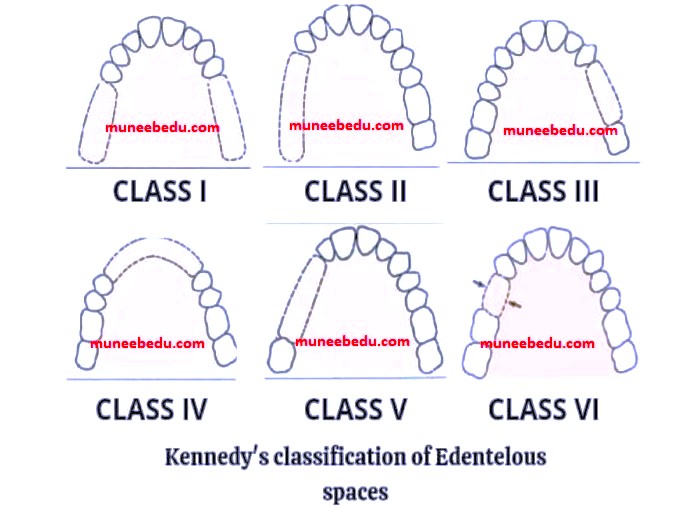RPD’s Removable Partial Denture
These are the prosthodontics that are used to replace the
missing teeth & supporting structures/tissues with a special designed prosthesis.
This prosthesis is removable by the wearer/patient.
 |
| Applegate's Rules & Kennedy's Classes |
Some common terminologies used for FPDS
What is an Appliance?
This device is worn by a patient during treatment course. Such
as
- Orthodontic Appliances
- Surgical Splints
- Space maintainers
What is an abutment?
This is a part of teeth, implant or structure on which our
prosthesis is placed and it provide
support to it.
What is Retainer?
Are also called Clasps. These are the fixation devices that
are applied directly to an abutment tooth and is used for the prosthesis
fixation.
What is interim Denture?
Interim is a temporary denture used for the short period of
time to fulfill the aesthetics, mastication until a definite form of treatment
can be rendered.
What is Transitional Denture?
This type of the denture may be used when loss of additional
teeth is inevitable but immediate extraction is not advisable. Artificial teeth
may be added to this type of denture.
Lets we discuss about the kennedy’s classification:
Background:
in 1923 Dr. Edward kennedy ( New York) proposed this classification.
This is the most popular classification among all classes. Unlike CUMMER,
Kennedy classified the partially edentulous arches & not denture.
There are 6 classes in Kennedy’s Classification system;
Class 1
 Bilateral edentulous area presents
at the posterior of the remaining natural teeth.
Bilateral edentulous area presents
at the posterior of the remaining natural teeth.
 |
| kennedy's class 1 |
Class 2
 Unilateral edentulous areas located
at the posterior to the remaining natural teeth. There is a single edentulous
space.
Unilateral edentulous areas located
at the posterior to the remaining natural teeth. There is a single edentulous
space.
 |
| Kennedy's class2 |
Class 3
 Unilateral edentulous areas that
are located anterior and posterior to it. It does not cross the midline like
class IV.
Unilateral edentulous areas that
are located anterior and posterior to it. It does not cross the midline like
class IV.
 |
| Kennedy's class 3 |
Class 4
Single, bilateral edentulous areas that are located anterior
to remaining natural teeth. This class crosses the midline.

 |
| Kennedy's class 4 |
Class 5
In this class edentulous areas are bounded anterior and
posterior by natural remaining teeth. In this type anterior abutment is not
suitable for support.

 |
class v kennedys |
Class 6
In this class edentulous areas are bounded anterior and
posterior by natural remaining teeth. In this type anterior abutment is suitable
for support.
 |
| class 6 |
Note:
- Class 3 has short and long Span.
- Class 5
and 6 are the modified forms of Applegates Rules.
Now we are discuss about the APPLEGATE’S Rules:
There are eight ( 8 ) Rules.
Rule# 01
Classification should follow the extraction.
Rule# 02
If third 3rd molar is miss and patient don’t want
to replace it, it will not be considered in the classification.
Rule# 03
If third 3rd molar is miss and acts as an
abutment it will be considered in the classification.
Rule# 04
If 2nd Molar is miss and it is not to be replaced
then it is not considered in the classification.
Rule# 05
Posterior edentulous areas always determine the classification/class.
Means like if we have anterior and posterior edentulous space then our Posterior
space or areas always determine our classification ( Kennedys classification),
and remaining space determine the modification.
Rule# 06
Edentulous areas other than those which determines the class
are referred to as modification designed
by their number.
Rule# 07
The extent of modification is not considered, only the
number of edentulous areas are considered. Means if we have two edentulous spaces
most posterior will determine our class and remaining will determine our modification.
This modification is written in numbers. i.e. Class2-mod1








0 Comments